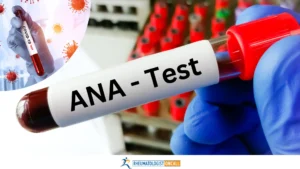SHARE
Are you curious about how doctors diagnose and treat autoimmune diseases? At the forefront of this process is a test you may have heard of, the ANA test. In this article, let’s explore the crucial role that Antinuclear Antibody (ANA) tests play in the autoimmune disorders world, from initial diagnosis to ongoing treatment monitoring.
What is an ANA test, and why is it so important in autoimmune diseases?
An ANA (Antinuclear Antibody) test is a blood test that detects antibodies that may attack your body’s own tissues. These antibodies, specifically targeting components of the cell nucleus, are often elevated in people with autoimmune diseases, but not only. But why is this test so critical?
First, the ANA tests serve as an initial screening test for a wide range of autoimmune diseases, from Lupus to Sjogren’s Disease or Rheumatoid arthritis. Second, when you develop different symptoms (like joint pain, rashes, or enlarged lymph nodes), the value of having a positive ANA test increases. Third, people with known autoimmune diseases who show an increase in the ANA titers (the level of antibodies detected) might reflect an increase in their disease activity.
How do doctors use ANA test results to diagnose autoimmune diseases?
The process of diagnosing an autoimmune disease is complex, and ANA test results are just a piece of the puzzle. Here’s how doctors typically use ANA results in the diagnostic process:
- Initial Screening: A positive ANA test often prompts further investigation into potential autoimmune conditions.
- Pattern Recognition: The specific pattern of ANA staining can provide clues about the type of autoimmune disease present. For example:
– A homogeneous pattern is often seen in systemic lupus erythematosus (SLE)
– A speckled pattern may indicate Sjögren’s syndrome or mixed connective tissue disease
– A nucleolar pattern is sometimes associated with scleroderma
- Titer Consideration: The ANA titer (the level of antibodies detected) can be significant. Higher titers are generally more likely to be associated with autoimmune diseases, though this isn’t always the case.
- Guiding Further Testing: Based on the initial ANA results, doctors may order more specific antibody tests. For instance:
– If lupus is suspected, tests for anti-dsDNA or anti-Smith antibodies might be ordered
– For suspected Sjögren’s syndrome, tests for anti-SSA and anti-SSB antibodies may be performed
- Differential Diagnosis: ANA results help doctors narrow down the list of potential conditions, guiding the diagnostic process more efficiently.
- Confirmation with Clinical Presentation: Doctors should always interpret ANA results in conjunction with a patient’s symptoms, physical examination findings, and other laboratory tests.
A positive ANA alone is not diagnostic of any specific condition.
What role does ANA play in treatment decisions for autoimmune diseases?
While ANA tests are used to guide toward an autoimmune disease diagnosis, their role in guiding treatment decisions is more nuanced. In the medical community, there is a big debate about whether the ANA test should play a role in guiding therapy. Here’s how ANA results can influence treatment approaches:
- Initiating Treatment: A positive ANA, along with clinical symptoms and other test results that led to an autoimmune disease diagnosis (e.g., lupus, Sjogren’s disease, scleroderma), may prompt the initiation of treatment.
- Treatment Selection: A further subset category of the ANA testing (e.g., positive SCL-70 or RNP-polymerase 3 antibodies) may indicate a higher risk of kidney involvement and thus avoidance of certain medications (like prednisone or methylprednisolone). Another example would be patients who have a positive ANA test are not good candidates for certain biologics (e.g., TNF-alpha inhibitors like adalimumab/ Humira or etanercept/ Enbrel) due to increased risk of developing drug-induced lupus.
- Monitoring Disease Activity: Changes in ANA levels (such as specific subtypes of ANA, such as Ds-DNA antibodies) may reflect disease activity in some autoimmune diseases (such as lupus). In some cases, rising DS-DNA antibody levels might precede a disease flare, allowing doctors to adjust treatment proactively.
However, it’s important to note that ANA levels don’t always correlate directly with disease activity in all patients or conditions.
What are the limitations of using ANA in treatment decisions?
While ANA tests are valuable, they do have limitations when it comes to treatment decisions:
- Not Always Correlated with Disease Activity: ANA levels don’t always reflect how active the disease is or how well a person is responding to treatment.
- Persistence After Treatment: Some patients may continue to have positive ANA results even when their disease is well-controlled or in remission.
- Non-specific: A positive ANA test doesn’t indicate which specific autoimmune disease a person has or if they have an autoimmune disease at all.
What other factors do doctors consider alongside ANA results?
Given the limitations of ANA tests, doctors consider multiple factors when diagnosing and treating autoimmune diseases:
- Clinical Symptoms: The patient’s reported symptoms (e.g., joint pain, enlarged lymph nodes, rashes, fever, fatigue, etc.) and their severity are crucial in guiding treatment decisions. A positive ANA test without any clinical symptoms does not require any treatment, but it may need to be monitored frequently.
- Physical Examination Findings: Objective signs of disease activity (e.g., swelling of the joints, rashes, edema in the legs etc.) observed during physical exams are important in guiding treatment.
- Other Laboratory Tests: Tests like erythrocyte sedimentation rate (ESR) and C-reactive protein (CRP) can indicate levels of inflammation in the body. Tests suggestive of severe anemia, low white blood cells, or low platelets might indicate an autoimmune disease like lupus. Tests that assess the kidney or liver function are essential. The further subsets of autoantibodies related to a positive ANA test are also crucial in understanding the type of autoimmune disease.
- Imaging Studies: X-rays, MRIs, or other imaging techniques can show the extent of organ involvement or damage.
How often should ANA tests be repeated during treatment?
The frequency of ANA testing during treatment varies depending on the specific autoimmune disease and individual patient factors. Here are some general guidelines:
- Initial diagnosis: ANA tests are typically performed during the initial diagnostic workup. If an autoimmune disease is suspected and the ANA test is positive, a subset of autoantibodies more specific for different autoimmune diseases is ordered to better understand the type of disease the patient has. For example, DS-DNA antibodies are specific for Lupus, while SSA and SSB antibodies are seen more in patients with Sjogren’s Disease.
- Known autoimmune disease: If a patient has a known autoimmune disease, ANA re-testing is not usually necessary since an increase or decrease in titer does not correlate with disease activity. The only autoantibody that correlates with disease activity is the DS-DNA antibody in lupus patients.
- Reassess diagnosis: ANA can be retested if it was initially mildly positive, but the patient has now developed new symptoms that require a diagnosis re-evaluation.
- Medication-induced reactions: An ANA test is often ordered in patients who develop new symptoms (e.g., rashes, joint pain) and are taking certain medications (e.g., hydralazine, TNF-alpha inhibitors, antibiotics)
Remember, these are general guidelines, and the exact frequency of testing should be determined by your rheumatologist based on your specific condition and circumstances.
Get Expert Care from Rheumatologist OnCall
Understanding the role of ANA in diagnosing and treating autoimmune diseases can be complex and often time confusing. If you’re dealing with a positive ANA test or symptoms that suggest an autoimmune condition, it’s crucial to consult with a rheumatology expert.
At Rheumatologist OnCall, we offer:
- Expert interpretation of ANA tests and other diagnostic information
- Comprehensive autoimmune disease diagnosis and management
- Convenient telemedicine appointments from the comfort of your home
- Personalized treatment plans tailored to your specific needs and ANA profile
Don’t let confusion about ANA tests or concerns about autoimmune symptoms hold you back. Take control of your health today.
Schedule your telemedicine or in-person appointment now at 650-525-4404 or [email protected].
While ANA tests are crucial in diagnosing and managing autoimmune diseases, they’re just one piece of the puzzle. At Rheumatologist OnCall, we look at the whole picture to provide you with the most accurate diagnosis and effective treatment plan. Let us be your partner in navigating the complex world of autoimmune disorders, providing expert rheumatological care when and where you need it most.














